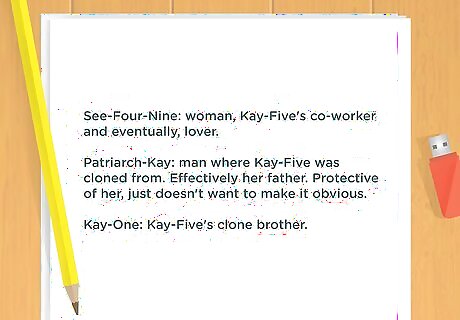
views
Brainstorming Ideas for the Novel

Think about a current technology that interests you. Dystopian novels often focus on current or future technology, and the impact it has on society. Maybe you are interested in self driving cars and what that will mean for people in the future. Or perhaps you want to focus on social media and the effects it will have or is having on society. Try taking a current technology and adding your own spin on it. You may add features to technology that complicate people’s lives or make it harder for them to connect. You could also create your own version of an existing technology by adding elements to it. For example, you may create a communications network that runs on how many likes you get on social media.

Focus on a global issue or problem. Dystopian novels often examine a current global issue or problem and critique it. You may be interested in a global issue like climate change or the disparity between rich and poor. Ask yourself how you can explore the issue or problem in your novel. Use the problem as the theme for your novel. For example, you may tackle the issue of climate change by creating a world where cities are underwater and people live with a limited supply of oxygen.

Write about a social or cultural concern. Use a social concern like gender or racism as the theme for your dystopian novel. Explore race and gender through your characters and your setting. You can also look at cultural issues like appropriation, corporate responsibility, or gentrification. For example, you may look at the effects of gentrification by creating a dystopian world where only a select group of young men thrive in modern, clean homes and the majority of women and old people live in sewers.

Ask yourself “what if?” Push yourself to imagine what might happen and what might be possible. Ask yourself, what if this happened and how would it affect our future? In a dystopian novel, the what if usually leads to dire consequences. Try to imagine what might happen if your “what if” came true. For example, you may wonder, what if no one had any rights except for a select group of people? What if women were only used for reproduction? What if corporations ruled the world?

Read examples of the dystopian novel. To get a better sense of the genre, read several dystopian novels that have been successful. Try reading a variety of novels in the genre to get ideas and get inspired. You may read: Brave New World by Aldous Huxley 1984 by George Orwell The Hunger Games by Suzanne Collins The Earthseed Series by Octavia Butler The Giver by Lois Lowry Son by Lois Lowry The Maze Runner by James Dashner

Think of a utopia that is achieved at horrifying costs. These are called "negative utopias." It might seem weird that you think of a utopia instead of a dystopia, but negative utopia books are some of the bestselling in the world. These books include: Brave New World by Aldous Huxley 1984 by George Orwell The Giver by Lois Lowry The Selection by Kiera Cass
Writing the Novel

Create the rules of the dystopian world. Write down a detailed account of the rules and regulations of your fictional dystopian world. You can then refer to these notes as you compose the novel. Having a clear set of dos and don’ts will make it easier for you to immerse the reader in the world of the novel. It will also ensure you keep the world consistent and easy to follow. To create the rules, ask yourself: What are the laws of the world? Is there a legal system, and if so, what does it look like? How are people punished for their actions? Does everyone receive the same punishment for their actions? What is considered taboo in the world?

Start with a strong opening. A strong opening line will set the tone for the rest of the novel and draw the reader in. Come up with a first line that is descriptive and unique. It should shock or startle the reader so they pay attention and read on. For example, you may go for a descriptive, moody opening like the first line of William Gibson’s Neuromancer: “The sky above the port was the color of television, tuned to a dead channel.” Or you may go for first lines that gives character and personality like Chuck Palahniuk’s Choke: “If you’re going to read this, don’t bother. After a couple pages, you won’t want to be here. So forget it. Go away. Get out while you’re still in one piece. Save yourself.”

Make the main character central to the story. Avoid making your dystopian novel just about the dystopian world. Have a protagonist that feels like the center of the story. Show them trying to survive in the dystopia. Make them the guide to the world for the reader. Having a strong main character will help readers feel a personal connection to the story. For example, you may have a main character who is employed by the shadowy government in control in the dystopian world. You may then show the main character struggling to help others overthrow the government.

Have well rounded minor characters. Do not simply let your minor characters feel like stand ins or caricatures. Make your minor characters just as detailed as your main character. Give your minor characters their own dramas, feelings, and conflicts to sort out. Show them struggling with the dystopian world and their role in it. For example, you may have a minor character who is the mother of the main character. She may try to help the main character succeed in overthrowing the shadowy government using her little known hacking skills.

Describe the world with sensory details. Put your reader in the dystopian world of the novel by describing how it smells, sounds, feels, looks, and tastes. Show your reader how it feels to walk in the world. Give your reader a sensory picture of the dystopian world so they can feel like they are really there. For example, you may describe the metallic smell of the government headquarters, run by robots. Or you may describe the charcoal taste of the food given to the poor and elderly.

Create conflict using the dystopian world. Use the dystopian aspects of the world to create conflict for your characters. The dystopian world should work against the characters so they feel trapped and restricted. They can then fight against the dystopia and try to get out of it or save others from it. For example, you may have a main character who tries to ignore the evil actions of the dystopian government until it affects their family. They may then decide to take on the government so they can free their family.
Polishing the Novel

Read the novel out loud. Once you have a draft of the novel, spend time listening to how it sounds out loud. Read passages of it aloud to yourself and to others. Listen for any awkward sentences or shifts in tone, where the language or vocabulary changes. Notice if the novel has a sense of rhythm and pacing. Reading the novel aloud can also help you catch spelling, grammar, and punctuation errors.

Show the novel to others. Critiquing your own work can be difficult. Get feedback from others to help you revise the novel. Ask friends, peers, family members, and teachers to read the novel. Have them give you feedback on whether they found the novel engaging, well paced, well described, and enjoyable to read.

Revise the novel. Once you get feedback, spend time revising the novel so it is at its best. You may need to rewrite whole sections of the novel or move sections around to help with pacing and character. Be willing to pull the novel apart and rework it. It can take many drafts to get the novel to the state that you want it to be.




















Comments
0 comment